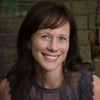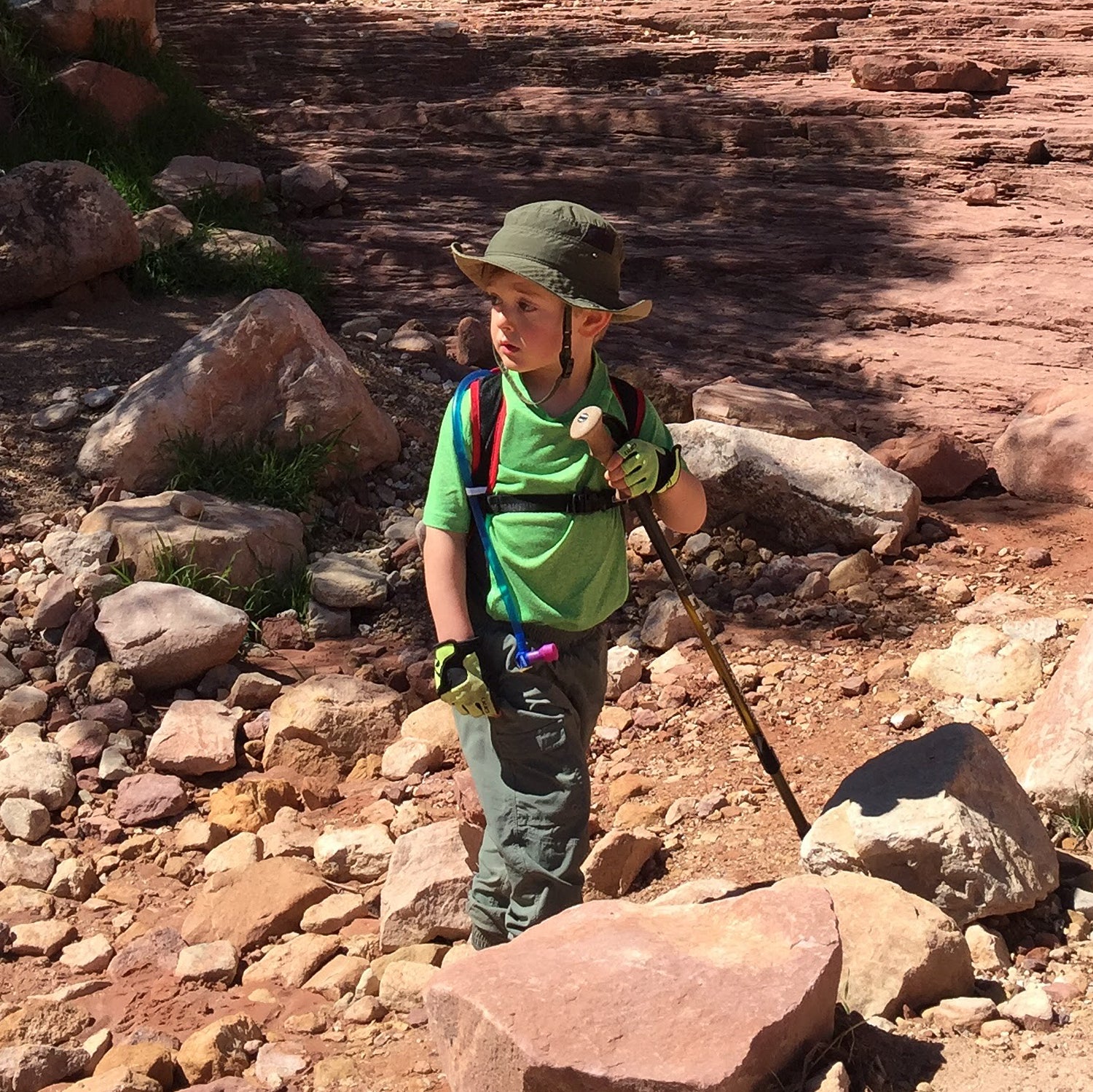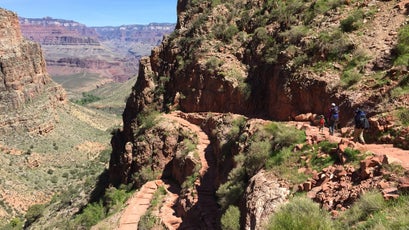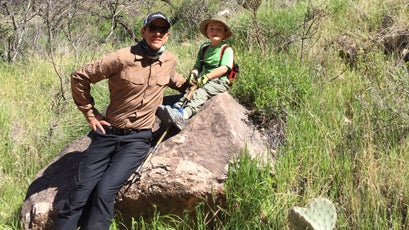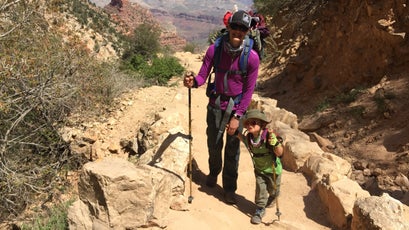Ask Sammy Hartley what he liked most about his unassisted hike of the Grand Canyon last month, and he’ll tell you it was the gummy cows he ate during snack breaks. That answer might seem a little weird, even by the standards of half-starved endurance hikers, until you learn that Hartley is just three years old.
Last month, Sammy and his parents completed the five-day, 25-mile trek down and up the canyon’s , , and Trails, for a total elevation change of about 11,000 feet. Luke and Sarah Hartley, both attorneys, say they’ve done everything they can to make sure their son’s life is filled with experiences like this one. The couple relocated from New York City to Denver in large part because they wanted their child to have unfettered access to the outdoors.
As soon as Sammy was born, the Hartleys took him to Colorado’s front range—first, in a kid carrier strapped to one of his parents’ backs. As soon as he could walk, Sammy wanted to tackle the expeditions himself. He’s already familiar with most of the trails on the Flatirons outside Boulder, along with several of the state’s more ambitious hikes. By the time he was 23 months old, Sammy was riding a BMX bike. Before his third birthday, he was tearing up jumps and pump tracks. This past winter, he skied all kinds of terrain at , and (he prefers the bumps and glades at each). He started rock climbing when he was two and has already bagged multi-pitch routes, including in Frisco, Colorado.
The Grand Canyon then, while undeniably ambitious, seemed a logical progression—and a safe one, says Luke, given its lodges and amenities at both the top and bottom of the trail. “Part of why we picked the Grand Canyon was because we could feel like we were deep in the backcountry without being so far away from the necessary support that we thought might be helpful in case the hike didn’t go the way we planned,” says Luke. “And Sarah carried Sammy’s kid carrier, so we knew we had a Plan B if he couldn’t hike the whole thing.”
The trip was also a for the , where Sarah is a board member. “We kept thinking, ‘Wouldn’t it be awesome if every kid like Sammy could go out as a three-year-old and have a lifetime of wilderness experiences?’” Sarah says.
They believe Sammy definitely understood that part of the trip. And while they’re not sure how much the magnitude of his hike resonated with him in the weeks leading up to it, he definitely knew he was going on a long, steep walk, and he was confident. But Luke admits there was a real moment of doubt when the family arrived at the national park to start the hike. “We got to the rim and were looking down into that canyon and realizing how huge it is,” says Luke. “I said to myself—because I never want to admit these things out loud—that this was crazy: there was no way he was going to hike this thing.”
Sammy disagreed. He put his favorite stuffed animal—a crocheted monster named Monster—into the kid carrier and the trio set off. The Hartleys planned their trip so that they’d never do more than five miles in a day. The rest they left up to Sammy and whatever the moment brought them. “We basically hiked from snack break to snack break,” says Luke.
Sarah says her initial worry was that Sammy would stop having fun along the way. To keep him enthusiastic, they sang a lot of songs and pretended they were a train. They ate Oreos dipped in peanut butter and lots of mac and cheese and, of course, the gummy cows. At night, they’d read books in their tent.
This approach to child-rearing isn’t new, of course. Back in the summer of 1956, Rachel Carson published her in The Woman’s Home Companion, the leading ladies’ magazine of the time and an adjudicator of all things domestic. There, Carson advocated for a world in which every kid had an immediate relationship with the natural world—and the kind of adventures that are a regular part of Sammy Hartley’s life. Carson maintained that what she called the “lasting pleasures of contact with the natural world” ought not be reserved for biologists. Instead, she wrote, they are “available to anyone who will place himself under the influence of earth, sea and sky and their amazing life.” Parents and kids alike, she concluded, would be well served to live under that influence.
A similar philosophy has driven initiatives like —where kids regularly spend their days sloshing in streams or learning about the ecosystems that exist under a fallen tree. It’s a particularly beneficial and effective model for raising kids, says William Hafford, a clinical psychologist and assistant professor of adventure therapy at Unity College who studies the role of nature in childhood development.
“We know that kiddos are learning machines—especially at Sammy’s age,” says Hafford. “They are positively wired to experience wilderness with every sense possible and in the most immediate way. The natural world fosters direct and sustained attention. It also provides for the idea of restorative and soft fascination: the chance to develop awareness of patterns and relationships in a way that’s a lot less fatiguing than staring at a screen.”
Recognition of these benefits remains far from ubiquitous. Luke and Sarah say they received their fair share of criticism from their peers when they announced their plans for the hike—everything from “you’re crazy” to suggestions of abuse. “There’s that fear you’re pushing the kid too hard, which is obviously not how this hike went,” Sarah says.
If Sammy had anything other than a blast, he’s not saying as much. Instead, what he really wants you to know is that he saw a king snake and a raven, and that he slept in a red sleeping bag, and most importantly, that he hiked all the way down and all the way up, and that it was good. And that just reinforces for his mom how important it is that other kids have similar opportunities.
“Sammy was so proud of his accomplishment,” says Sarah. “The message for me is that there’s so much you can learn at any age from being outside and doing things you didn’t think you could do. There’s a huge amount of character-building that comes from challenging yourself and reaching a summit, whether it’s an actual one or a small goal along your way. And if a three-year-old can accomplish this, imagine what a 13-year-old kid can accomplish, given half a chance.”
Taking little kids into wilderness settings isn’t always a cakewalk. Even the best prepared and most rugged little adventurer can go from zero to meltdown in no time. And Hafford cautions that, while they can seem incredibly resilient when it comes to whatever they shove in their mouths, there are other ways in which they don’t compensate nearly as well as adults. “When they crash, they crash quickly,” says Hafford. “It’s something to be mindful of. They can go along like radiators and then, an instant later, be showing signs of hypothermia. If you’re taking kiddos out into the wilderness, you need to be practiced in all kinds early warning signs.”
The Hartleys add that you also have to be really good at going slow. And that can take a newfound patience very different from what propels many of us up the trail. Hiking with a toddler, they say, means you stop to let a lone fire ant cross your path. You jump over a root not once, but ten or 12 or 20 times because it’s there. You stop and sit down every 20 minutes, especially if there’s a flower or a bird or the promise of another snack you can’t normally eat at home. And if you can give yourself over to that sort of thing, says Luke, the rewards can be pretty great.
“We saw a lot more minutia, and because Sammy noticed the beauty of those details, we did too. It was a deeper exploration of the trail at the micro level than I’d had in a long time.”

